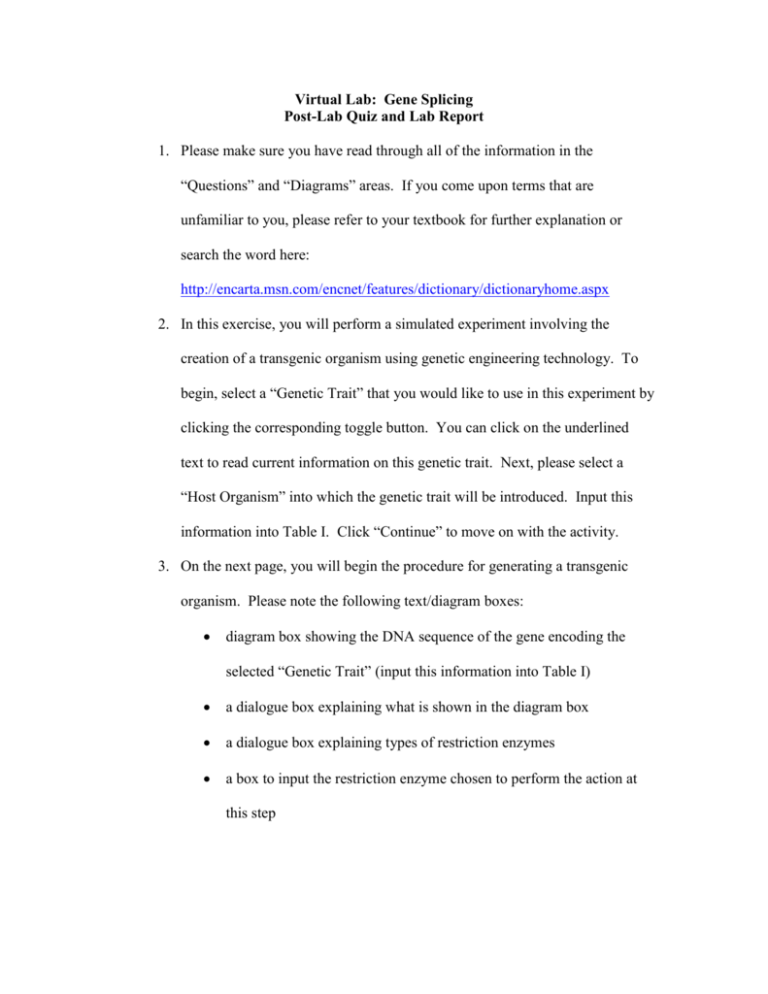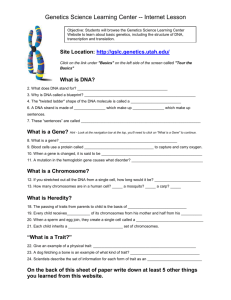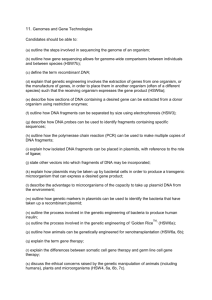Post Lab Quiz and Lab Report
advertisement

Virtual Lab: Gene Splicing Post-Lab Quiz and Lab Report 1. Please make sure you have read through all of the information in the “Questions” and “Diagrams” areas. If you come upon terms that are unfamiliar to you, please refer to your textbook for further explanation or search the word here: http://encarta.msn.com/encnet/features/dictionary/dictionaryhome.aspx 2. In this exercise, you will perform a simulated experiment involving the creation of a transgenic organism using genetic engineering technology. To begin, select a “Genetic Trait” that you would like to use in this experiment by clicking the corresponding toggle button. You can click on the underlined text to read current information on this genetic trait. Next, please select a “Host Organism” into which the genetic trait will be introduced. Input this information into Table I. Click “Continue” to move on with the activity. 3. On the next page, you will begin the procedure for generating a transgenic organism. Please note the following text/diagram boxes: diagram box showing the DNA sequence of the gene encoding the selected “Genetic Trait” (input this information into Table I) a dialogue box explaining what is shown in the diagram box a dialogue box explaining types of restriction enzymes a box to input the restriction enzyme chosen to perform the action at this step Once you have completed this step, click “Continue”. A new dialogue box will appear if your enzyme choice is incorrect. Make a new selection after rereading the information and click “Continue” to advance to the next step. Input this information into Table I when you are through. 4. In the next step, you need to place the isolated DNA fragment into a bacterial plasmid. To do this, look at the DNA sequence given (this is what you just cut out in the previous step) and choose the same enzyme in two separate selections that will create these base overhangs in the plasmid (hint: should it be the same enzyme used in the previous step?). Click “Continue” when you are done; a dialogue box will appear if you chose the incorrect enzyme. Reread the information and make a new selection to advance to the next step. Input this information into Table I when you are through. 5. In the last page, you will learn if the transgenic organism you created was viable or not. Input this information into Table I when you are through. You can redo the experiment with a different combination of “Genetic Traits” and “Host Organisms” if you wish by clicking the button at the bottom of this page. 6. Please finish this exercise by opening the “Journal” link at the bottom of the page and answering the questions. Table I: Genetic Trait Host Organism DNA sequence of Genetic Trait (gene) Restriction Enzyme used Post-laboratory Questions: 1. The glow-in-the-dark trait gene: a. Comes from a firefly b. Comes from E. coli c. Could be used in anti-HIV drug development d. A and C 2. Antifreeze plasma proteins: a. Have been isolated in species of flounder b. Allow some species of fish to grow at very hot temperatures c. Allow some species of fish to grow at very cold temperatures d. A and C e. All of the above 3. Insulin: a. Can be produced in genetically engineered bacteria b. Can be produced in cloned cows c. Can be produced more cheaply in cow’s milk d. B and C e. All of the above Viable Transgenic Organism Made (Y/N) 4. The rot-resistant trait: a. Was introduced into the Flavr Savr tomato b. Is due to antisense suppression of polygalacturonase c. Increased the cost of processed tomato products such as tomato paste d. A and B 5. Genes have NOT been successfully introduced (“spliced”) into: a. Prokaryotes b. Plants c. Animals d. None of the above 6. Restriction enzymes: a. Were originally isolated from bacteria b. Only cut DNA at random sequences c. Can cut DNA at specific sequences d. Always leave blunt ends e. A and C 7. A proper Watson-Crick DNA base pair is: a. A-G b. C-T c. A-T d. None of the above 8. “Sticky ends” allow DNA fragments to be spliced into vectors by what type of bonding? a. Ionic b. Covalent c. Hydrogen d. None of the above 9. The enzyme ligase: a. Cuts DNA and creates blunt ends b. Cuts DNA and creates sticky ends c. Completes the splicing of DNA fragments and plasmid vectors d. None of the above 10. You cut a vector with the following DNA base overhang (“sticky end”): ACCTGGACTTA CCTGAAT You will need to cut out the DNA fragment containing your gene of interest so that which sticky end is created? a. XXXXXXXX XXXXXXXXTGGA b. XXXXXXXX XXXXXXXXACCT c. XXXXXXXX XXXXXXXXTCCA d. XXXXXXXX XXXXXXXXATTC








